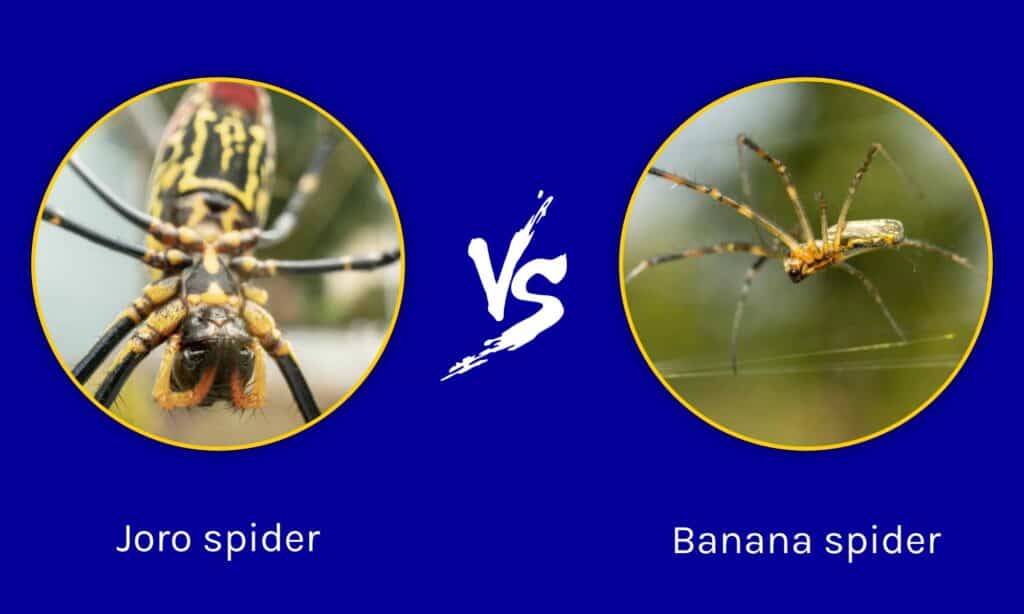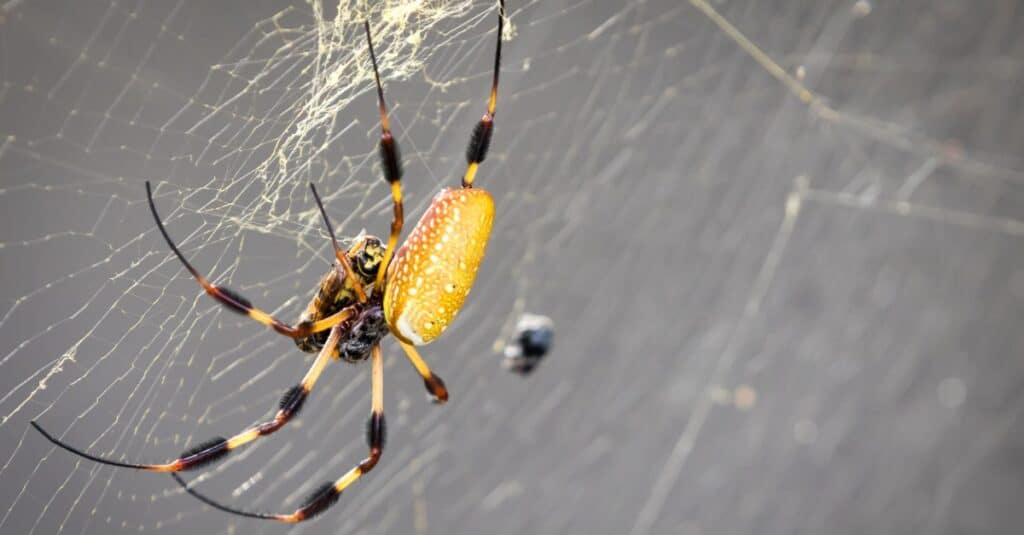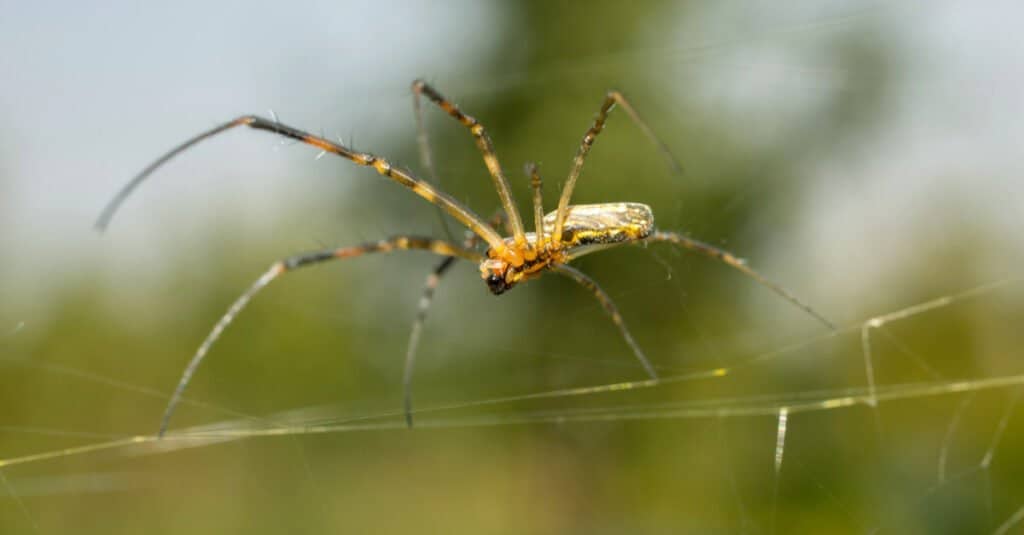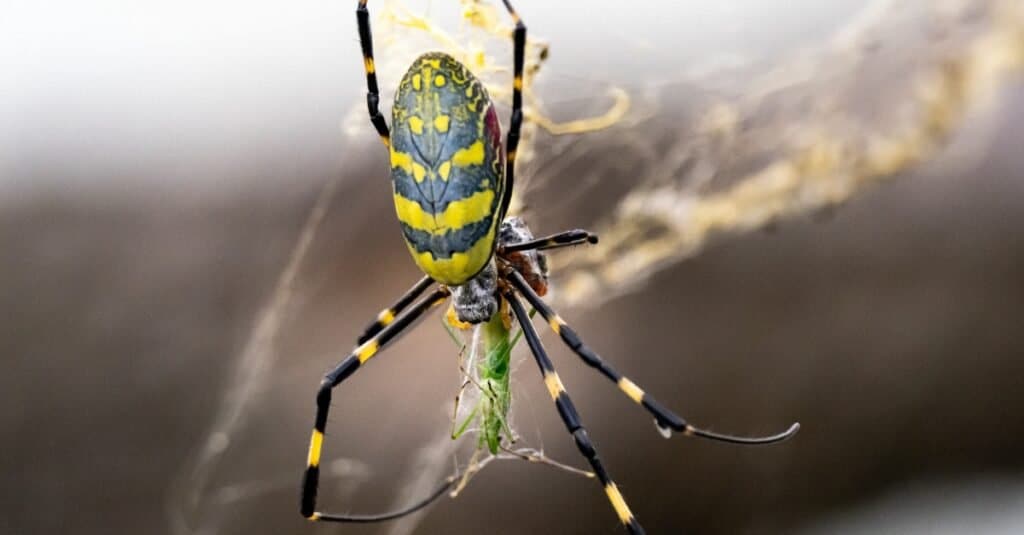
The post Joro Spider vs Banana Spider: What Are the Differences? appeared first on A-Z Animals.
Spiders can be interesting, beautiful, and frightening creatures depending on the person you ask. Sadly, misinformation about spiders and their potential danger has cast some of these arachnids in a bad light. Two spiders that are sometimes mistakenly believed to be related and also maligned are the Joro spider and the banana spider. Today, we’re going to explore each creature and define the differences between a Joro spider vs. banana spider.
This post was updated on October 11, 2025 to clarify the banana spider recent taxonomic change, length, coloration, and confusion between the banana spider and the Brazilian wandering spider.
Comparing a Joro Spider and a Banana Spider

| Joro Spider | Banana Spider | |
|---|---|---|
| Size | Body Length – 0.7-1 inch Legspan – 3-4 inches |
Body Length – 0.8-1.2 inches Legspan – 5 inches |
| Genus/Species | Trichonephila clavata | Trichonephila clavipes |
| Color | Females – Bright yellow abdomen marked with red and blue stripes, with blue and yellow banded legs. Males – Brown |
Yellow-gold body with white markings in spots or a pattern. Legs are black with yellow bands. |
| Location | – Japan, Korea, China, Taiwan – Lives in Georgia and South Carolina as a non-native species but is also spreading up the East Coast. |
– Asia, Africa, Oceania, North America – Prefer to live in warm climates |
| Danger to Humans | – Its bite is not dangerous to humans or their pets – Eats a variety of annoyance creatures, including stinkbugs and mosquitoes |
– Venomous bite that can affect humans – Will lead to redness and mild pain |
The Key Differences Between a Joro Spider vs. Banana Spider

The banana spider uses its web to catch prey.
©iStock.com/NikonShutterman
Joro Spider vs Banana Spider: Size
The Joro spider is larger than a banana spider, including its leg span, but the banana spider has a larger body. Female Joro spiders have a body that reaches a length of 0.7in-1in, with leg spans of between 3-4 inches. Banana spider females have a body measuring 0.8-1.2 inches, and a 5-inch leg span. Males of both species are much smaller than females, with a body measuring 0.25 to 0.35 inches.
Joro Spider vs Banana Spider: Family, Genus, and Species
Both Joro and the banana spiders are in the orb-weaver family (Araneidae).
In terms of genus, there is no great difference between the Joro spider and banana spider. While banana spiders (golden silk orb-weavers) were traditionally classified under the Nephila genus, recent taxonomy places them in Trichonephila, the same genus as the Joro spider.
Though they are both golden orb weavers and closely related, they are separate species. The Joro spider’s scientific name is Trichonephila clavata, while the banana spider’s scientific name is Trichonephila clavipes.
Joro Spider vs Banana Spider: Color

Banana spiders can be very yellow, making them easy to confuse with the Joro spider in some cases.
©Yaping/Shutterstock.com
Both Joro spiders and banana spiders are multicolored, and their colors can vary. Female Joro spiders have a bright yellow abdomen marked with red and blue stripes, with blue and yellow banded legs. Males are brown.
Banana spiders vary in color, but they typically feature a yellow-gold body with white or orange markings in spots or a pattern. Legs are black with yellow bands.
Joro Spider vs Banana Spider: Location
Banana spiders are widespread around the world, preferring warm areas in Africa, Asia, Oceania, and North America.
The case of the Joro spider is interesting. Its original range only included Japan, Korea, China, and Taiwan, but it is now also in the United States as a non-native species. Currently, they have been spotted in Georgia and South Carolina, but they’re moving across the south and farther north, too.
These spiders use their silk to help them create “balloons” so that they can float long distances. If you’re on the East Coast of the United States, be on the lookout: these spiders may be floating into a town near you!
Joro Spider vs Banana Spider: Danger to Humans

Joro spiders may look deadly, but they’re not harmful to people.
©iStock.com/David Hansche
One of the questions on the minds of people that see these spiders is, can this arachnid hurt me? The banana spider is a venomous spider like most other spiders, and it uses that venom to kill its prey. Moreover, this spider is capable of biting human beings. However, the banana spider does not refer to Brazilian wandering spiders (Phoneutria), which are highly venomous — a common confusion online.
When banana spiders bite people, they don’t hurt them badly. A bite from this spider will lead to redness around the bite area and some mild pain in most cases.
Joro spiders are not dangerous to humans or their pets. They simply do not have fangs long enough to penetrate the skin of humans or pets. Moreover, these spiders are deadly to other annoying insects like stink bugs and mosquitos, creatures that few humans will miss.
The Joro spider and banana spider may seem similar in terms of the webs they spin, but they are different species. Although both spiders can now be found in North America, neither poses a significant threat to humans.
The post Joro Spider vs Banana Spider: What Are the Differences? appeared first on A-Z Animals.
October 11, 2025 at 07:02PMKyle Glatz
.jpeg)
.jpeg)

0 Comments